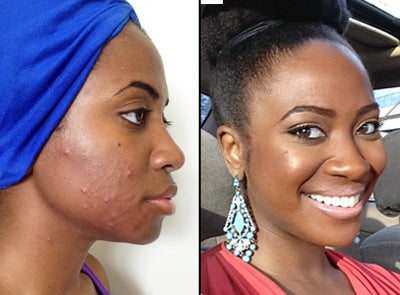
As a teen, it’s normal to have a few breakouts here and there. But when you enter your 30’s and your skin is still wrought with pimples and blemishes, it can be a major blow to your self-esteem.
That was my story. Growing up, I probably got a pimple once a month and pretty much used the same Origins face wash year after year. But shortly after my 25th birthday, my battle with adult acne began and it’s still an ongoing struggle, even as I’ve entered my 30’s.
As a full-time beauty writer, my acne feels even more profound since I’m constantly interviewing skincare experts and attending events where most women in the room have near-flawless skin. I think to myself in frustration, Shouldn’t I have the resources and knowledge to get my skin fixed by now, geesh?!
It’s been six years since my adult acne surfaced, and during that time I’ve learned that the first step to calming my skin starts within. Even as I’ve visited three different dermatologists over the years, I look back and realize that only when I was able to push past the insecurity about my skin did I feel empowered to take action to correct the problem from the inside, out. Once I eased my anxiety about breakouts, along with sticking to my dermatologist-recommended skincare routine, my breakouts no longer had a hold on me and my acne started to improve. Today, at 31, I’m happy to say my acne is finally completely under control.
Since my first visit to the dermatologist in 2009, here are the treatments that have worked for me:
1. Acanya Gel: This is prescription strength benzoyl peroxide which is an antibacterial gel that helps dry up pimples. Acanya also contains clindamycin phosphate, which is a topical antibiotic.
2. Retin-A: This is a retinoid which helps to unclog pores and speed up skin cell turnover.
3. Differin: This is also a retinoid, but it’s milder than Retin-A.
4. Aczone: This is an antibacterial and anti-inflammatory gel to calm the redness and swelling from pimples.
Note: Benzoyl peroxide has been shown to deactivate retinoids, so I don’t layer Acanya with the Retin-A or Differin.
Keep in mind that I didn’t use all of the above simultaneously. In my case, there were certain treatments that worked for a year or two, but then began to have diminished results. Thus, my dermatologist would switch me over to something else. In your skincare journey, you may also notice what worked once may no longer be effective later on, so keep track of your results every three to six months.
My skincare routine would not be complete without also incorporating lifestyle changes. It’s so true that outer beauty starts from within, so here’s what’s been important for me to keep my skin under control:
1. I must get sleep. I had no clue that my 20-something “sleep-is-optional” lifestyle was wrecking havoc on my skin. Ditch the late-night reruns and get some shuteye instead.
2. Water, water, water! At the height of my acne breakouts, I went on a water-only routine, removing all juice, soda, iced coffee and everything else out of my diet. Go out and buy a cute water bottle that will encourage you to keep chugging all day long.
3. Exercise. Breaking a sweat helps to improve bloodflow to the skin, which can calm inflammation. Exercise also releases feel-good endorphins which gave me boosts of confidence on days I may have been feeling a little low.
4. Being consistent. I still get asked to review skincare products, and I do, but I’m cautious about throwing off my routine. Right now, I’m using the Obagi 360 kit and my skin LOVES it. I also look for buzzwords such as “non-comedogenic” and “oil-free” in the fine print on all product labels. This tells me that the product won’t clog pores, which could potentially lead to flare-ups.
5. I do not — I repeat, DO NOT— pick at pimples! There are some cases where a small bump will be bright white and I feel comfortable using a sterilized whitehead tool to gently release the pus. Otherwise, I have a strict “hands off” policy.
If you struggle with adult acne, here is my advice:
1. You must see a dermatologist. Most visits are fully covered by your insurance, but the cortisone shots may not be (mine were only partially covered since it’s considered “cosmetic”). Talk to a professional and your insurance company about a plan that’s right for you.
2. Keep your makeup very light. I know you will want to cover up your blemishes, but some of the chemicals can do more harm than good, especially if you’re wearing heavy concealers and foundations every day. Lightweight tinted moisturizers are great for covering dark spots without clogging pores. I love Cosmedicine Medi-Matte Tinted Moisturizer.
3. Monitor your diet. My #1 acne trigger food is meat. Animals have hormones, and, since acne breakouts are triggered by hormonal fluctuations, my body can’t handle meat every day. I eat meat once or twice a week and sometimes less frequently than that. Figure out what your trigger foods are and limit your intake of them.
4. Be kind to your skin. This is a temporary season and I promise that with the right regimen and dermatologist, your skin will improve. Be patient with your journey and always remember your true beauty comes from within.
